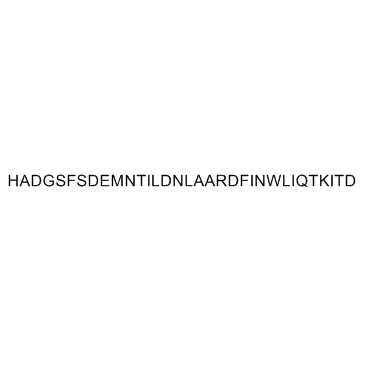| Description |
GLP-2(1-33) (human) is an enteroendocrine hormone which can bind to the GLP-2 receptor and stimulate the growth of intestinal epithelium.
|
| Related Catalog |
|
| Target |
GLP-2 receptor[1]
|
| In Vitro |
GLP-2-treated group demonstrates a 518±22% increase (P<0.05) in mucosal IGFBP-4 mRNA levels as compare with vehicle-treated controls. Because the mucosal expression of IGFBP-4 transcripts is found to be very low relative to that of the whole intestine, FRIC cultures are used as an in vitro model of the entire intestine. FRIC cultures have previously been established to express a functional GLP-2 receptor (GLP-2R) that displays a cAMP response, as well as enhances IGF-1 mRNA expression and IGF-1 secretion in response to GLP-2 treatment. When incubates with GLP-2 (10−8 M) for 2 hours, IGFBP-4 mRNA expression in the FRIC cultures is also found to be increased, by 40.8±15.2% (P<0.05), compare with vehicle-treated cells[1].
|
| In Vivo |
GLP-2 quickly increases apoB48 mass in the TRL fraction of plasma, which is indicative of chylomicron number, and this is blocked by L-NAME. GLP-2 treatment alone increases postprandial TRL-lipids (slope 3.65±0.73×10−3 g/L/min vs 1.63±0.28×10−3 g/L/min, GLP-2 vs control), and this effect is completely mitigated by L-NAME pretreatment (slope 3.67±0.15×10−4 g/L/min). The GLP-2-induced rise in TRL-apoB48 occurres within 30 minutes and precedes the rise in TRL-TG. GLP-2 acutely increases plasma tritium levels (slope, 1.66±0.25×102 dpm/mL/min vs 1.11±0.17×102 dpm/mL/min, GLP-2 vs control)[2].
|
| Cell Assay |
Fetal rat intestinal cells (FRICs) are collected by enzymatical digestion of whole fetal rat intestines (mixed sex) and cultured overnight in DMEM containing 4.5 g/L glucose, 5% fetal bovine serum, and 40 U/mL penicillin and 40 μg/mL streptomycin in 10 cm plates. Cells are then treated with GLP-2 (10−8 M) or vehicle in low-glucose DMEM with 0.5% FBS for 0.5 to 24 hours[1].
|
| Animal Admin |
Hamsters that undergo intraduodenal catheterization (idc) are allowed 7 days of recovery before jugular vein catheterization. For postprandial experiments, conscious fasted (16 h) hamsters receive a 75 mmol/kg iv bolus of L-NAME. After 10 minutes, baseline blood sample is collected (time 0), followed by an oralgastric gavage of 3 μL Ci [9,10-3H(N)] triolein in 200 μL olive oil. At t=10 minutes, F-127 is given ip (1 g/kg) to inhibit peripheral TG-rich lipoprotein (TRL) catabolism. At t=20 minutes, the hamsters receive ip injections of either PBS or 0.25 mg/kg human GLP-2(1-33). Blood (400 μL) is collected every 30 minutes for 2 hours. Blood is centrifuged at 6000 rpm for 10 minutes at 4°C to isolate plasma. Radioactivity is assessed using a liquid scintillation counter[2].
|
| References |
[1]. Kaori Austin, et al. IGF Binding Protein-4 is Required for the Growth Effects of Glucagon-Like Peptide-2 in Murine Intestine. Endocrinology. 2015 Feb; 156(2): 429-436. [2]. Hsieh J, et al. Glucagon-Like Peptide 2 (GLP-2) Stimulates Postprandial Chylomicron Production and Postabsorptive Release of Intestinal Triglyceride Storage Pools via Induction of Nitric Oxide Signaling in Male Hamsters and Mice. Endocrinology. 2015 Oct;156(10):3538-47.
|
